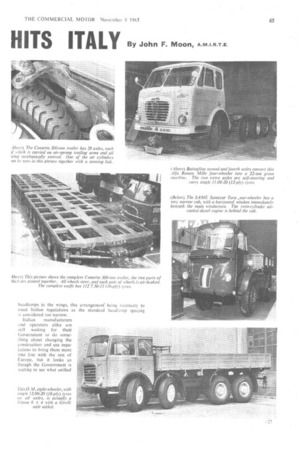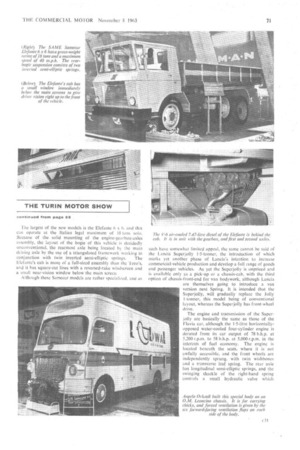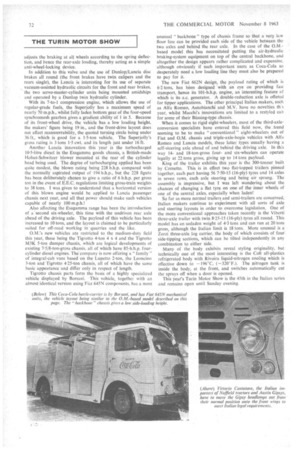EIGHT-WHEELER FEVEA
Page 70

Page 71

Page 72

Page 75

Page 76

If you've noticed an error in this article please click here to report it so we can fix it.
HITS ITALY By John F. Moon, A.M.I.R.T.E.
IN my report of the 1962 Italian Motor Show I made reference to the appearance on one or two stands of eight-wheeled rigid vehicles which in most cases had been converted from factory-built six-wheelers. At that time the conversions were restricted to Fiat and O.M. chassis, and I must confess that I regarded it more as yet another passing phase by Italian operators and manufacturers intended to overcome the 18-ton-gross legal limitation applied to six-wheeled vehicles.
Before I got to this year's Show I had seen a surprising number of rigid eights on the roads of Turin-and its surrounding areas, and this was indication enough that such vehicle types had caught the imagination of Italian hauliers. It was no great shock, therefore, to find a dozen or more eight-wheeled rigids inside the Show, and I think it can be safely said that Italy has now become Europe's second largest operator of rigid eightwheelers, some of which look like British machines in having a 2+2 axle layout whilst others have a less conventional 1+3 configuration, in which case two of the three rear axles are usually of the self-steering type.
This flush of eight-wheeled chassis is by no means the only interest at this year's Turin Show, which is the first, incidentally, not to feature buses and coaches, Passenger vehicles only are to be exhibited at the 1964 Show, arid if that Show attracts as many bus and coach manufacurers as this year's has goodsvehicle makers, it will obviously be one of the most interesting passenger-model exhibitions to have been held in Europe. As recorded in last week's issue, there is one completely new chassis manufacturer at Turin this year, this being the agricultural-tractor manufacturer, SAME, who has developed some quite original haulage vehicles with a number of novel features. Another completely new vehicle is the Lancia Superjolly 1•5-tonner, which uses Lancia Flavia private-car mechanical units and is unique for a vehicle of its size in having disc brakes at all four wheels.
Lancia have joined the horse-power race which started in earnest last year by turhocharging their 10-5-litre six-cylinder diesel, and Fiat have filled a gap in their medium-capacity range with the introduction of the 662N 10-ton-gross model. Other new vehicles include 4 x 4 and tipper versions of the O.M. Tigrotto medium-duty four-wheeler, whilst trailer exhibits range from light boat carriers to the Cornett° 300-tonner.
Britain's two best-sellers of goods vehicles in Italy. Ford and Vauxhall, have quite generous Thames and Bedford displays. Rover have a left-hand-drive forward-control model on show, whilst the dieselengined Austin Gipsy exhibit displayed by Vittorio Cantatore has a remodelled front-end with cowled headlamps in the wings, this arrangement* being necessary to meet Italian regulations as the standard headlamp spacing k considered too narrow.
Italian manufacturers and operators alike are still waiting for their Government to do something about changing the construction and use regulations to bring them more into line with the rest of Europe, but it looks as though the Government is xaitirtg to see what unified EEC. regulations will be drawn up before it makes a move, which makes sense taking the long-term viewpoint, but is causing a lot of frustration around the commercial-vehicle industry in the meantime. Despite reduced tariffs, which nominally should make it easier for non-Italian makers to sell their products in Italy, Italian manufacturers have actually increased their home-market sales by an estimated figure of 16 per cent compared with last year, the official total calculated for 1963 being 80,000 units, which includes buses and coaches, of course.
On the other hand, exports are dropping, and the estimated figure of 12,000 vehicles for this year is 12 per cent less than last year's actual total. This again can be put down to Italian regulations being so out of step with those in the rest of Europe that most of their chassis are not acceptable outside Italy. That imports of goods and passenger vehicles into Italy has increased is shown by the 24-75 per cent climb in vehicle registrations, and a rough calculation involving the production, export and registration figures shows that something like 19,000 goods and passenger vehicles are due to be registered in Italy this year which were not manufactured in that country, and this total is approximately 5,000 higher than last year's.
Although essentially a national Show, foreign interest in the Italian market is reflected by the number of non-Italian exhibitors among the commercial-vehicle sections, with four French, nine German and one Spanish make being represented, in addition to the four British and eight Italian. The Spanish contribution is by Pegaso, and this Leyland-associated company is showing .a Pegaso-Comet fire appliance and two heavier goods models in which the Leyland theme is apparent also. None of the other " foreign" exhibitors features anything that hasn't been seen before at the Frankfurt Show last September.
Even a visitor to the Show who did not know the farm-tractor background of the SAME company would soon be able to guess at this, for all the Samecar exhibits have a tractor-type enginegearbox-rear-axle unit, the front axle also being bolted to this assembly so that all mechanical units are unsprung. There are two basic models in this new range, the smallest being the Toro.
This has a SAME vertical-twin air-cooled diesel with a capacity of 2-49 litres and direct injection. Its gross output is
c28 45 b.h.p. at 2,300 r.p.m. and the torque rating is in the region of 120 lb. ft. The gearbox gives six forward and three reverse speeds; whilst the rear axle is a double-reduction assembly, with outboard spur-gear secondary trains, the front axle being a single-reduction assembly. A split air-hydraulic , footbrake system is employed, and the handbrake acts on two band-type assemblies incorporated with the primary gearing of the rear axle.
The Toro V version of this design is a straight load carrier with a load rating of 2-5 tons, and this is suitable for tipper and dumper bodies. The Toro AT has lower gearing, and this is suitable for use with trailers, the total allowable payload in this case being 7.5 tons. The Toro TS is a road tractor pure and simple, its low gearing giving a maximum speed of less than 20 m.p.h., but its gross rating being about 20 tons for normal road work, although the makers claim the ability to move 190 tons in bottom gear at 1-6 m.p.h.
Because the Toro's engine lies behind the cab, the cab itself is narrow without being cramped, but for the same reason the engine intrudes into the cargo space when conventional bodies are fitted.
The other Samecar basic design is the Elefante, and this is a considerably more powerful machine, available with two or three axles. The chassis layout is similar to that of the Toro, but the engine is a V-6 version of the same basic unit, this having a capacity of 747 litres and a maximum gross rating of 140 b.h.p. at 2,300 r.p.m., the torque output being 225 lb. ft. As a four-wheeled tractive unit the Elefante ATR can cape with , a 20-ton semi-trailer, whilst the TS-type road tractor can operate at 32 tons gross train weight, the tractor weight of S tons including 3 tons of ballast over the rear axle, These two vehicles have four-wheel-drive, and the gearbox gives eight forward and four reverse speeds.
The largest of the new models is the Elefante 6 x 6, and this can operate at the Italian legal maximum of 18 tons solo. Because of the . solid mounting of the engine-gearbox-axles assembly, the layout of the bogie of this vehicle is decidedly unconventional, the rearmost axle being located by he matn driving axle by the use of a triangulated framework working in conjunction with twin inverted Semi-elliptic springs. The Elefante's cab_ is more of a full-sized assembly than the Toro's, and it has square-cut lines with a reversed-rake windscreen and a small near-vision window below-the main screen
Although these Samecar models are rather speciaEted. and as such have somewhat limited appeal, the same cannot be said of the Lancia, Superjolly 1.5-tonner, the intrOduction of which marks yet another phase of Lancia's intention to increase commercial-vehicle Production and develop a full range of goods and passenger vehicle's. As yet the Superjolly is unpriced and is available only as a pick-up Or a chassis-cab, with the third option of chassis-front-end for van bodywork, although Lancia are themselves going to introduce a van version next Spring. It is intended that the Superjolly, will gradually replace the Jolly 1-tonner, this model being of conventional layout, whereas the Superjolly has front-wheel drive.
The engine and transmission of the Superjolly are basically the same. as those of the Flavia car, although the 1.5-litre horizontallyopposed water-cooled four-cylinder engine is derated from its car output of 78 b.h.p. at 5,200 r.p.m. to 58 b.h.p. at 5,000 r.p.m. in the interests of fuel economy. The engine is located beneath the seats. where it is not awfully accessible, and the front wheels are independently sprung, with twin wishbones and a transverse leaf spring. The rear axle has longitudinal semi-elliptic springs, and the swinging shackle of the right-hand spring controls a small hydraulic valve which adjusts the braking at all wheels according to the spring deflection, and hence the rear-axle loading, thereby acting as a simple anti-wheel-locking device.
In addition to this valve and the use of Dunlop/Lancia disc brakes all round (the front brakes have twin calipers and the rears single), the Lancia is interesting for its use of separate vacuum-assisted hydraulic circuits for the front and rear brakes, the two servo-master-cylinder units being mounted amidships and operated by a Dunlop twin hydraulic cylinder.
With its 7-to-1 compression engine, which allows the use of regular-grade fuels, the Superjolly has a maximum speed of nearly 70 m.p.h., whilst fully laden bottom gear of the four-speed synchromesh gearbox gives a gradient ability of 1 in S. Because of its front-wheel drive, the vehicle has a low loading height, the makers' figure being 19 in., and the front-drive layout does not affect manceuvrability, the quoted turning circle being under 36 ft., which is good for a 1.5-ton vehicle. The Superjolly's gross rating is 3 tons 1-5 cwt. and its length just under 16 ft.
Another Lancia innovation this year is the turbocharged 10-5-litre diesel in the Esagarruna goods chassis, a British-made liolset-Schwitzer blower mounted at the rear of the cylinder head being used. The degree of turbocharging applied has been quite modest, the blown rating being 228 b,h.p, compared with the normally aspirated output of 194 b.h.p., but the 228 figure has been deliberately chosen to give a ratio of 6 b.h.p. per gross ton in the event of E.E.C. regulations limiting gross-train weights to 38 tons. I was given to understand that a horizontal version of this blown engine would be applied to Lancia passenger chassis next year, and all that power should make such vehicles capable of nearly 100 m.p.h.!
Also affecting the Esagamma range has been the introduction of a second six-wheeler, this time with the undriven rear axle ahead of the driving axle. The payload of this vehicle has been increased to 10 tons, and the layout is claimed to be particularly suited for off-road working in quarries and the like.
0.M.'s new vehicles are restricted to the medium-duty field this year, these being the Tigrotto 4-ton 4 x 4 and the Tigrotto M3K 5-ton dumper chassis, which are logical developments of existing 7-5/8-ton-gross chassis, all of which have 85-b.h.p. fourcylinder diesel engines. The companyis now offering a "family" of integral-cab vans based on the Lupetto 2-ton, the Leoncino 3-ton and Tigrotto 4-25-ton chassis, all of which have the same basic appearance and differ only in respect of length.
Tigrotto chassis parts form the basis of a highly specialized vehicle displayed by Borsani, This vehicle, together with an almost identical version using Fiat 645N components, has a most unusual " backbone" type of chassis frame so that a very Icw floor line can be provided each side of the vehicle between the two axles and behind the rear axle. In the case of the O.M.based model this has necessitated putting the air-hydraulic braking-system equipment on top of the central backbone, and altogether the design appears rather complicated and expensive, although obviously if such important users as Coca-Cola so desperately need a low loading line they must also be prepared to pay for it.
The new Fiat 662N design, the payload rating of which is 6.2 tons, has been designed with an eye on providing fast transport, hence its 101-b.h.p. engine, an interesting feature of which is its a.c. generator. A double-reduction axle is offered for tipper applications. The other principal Italian makers, such as Alfa Romeo, Autobianchi and M.V. have no novelties ths year, whilst Macchi's innovations are limited to a restyled cab for some of their Bussing-type chassis.
When it comes to rigid eight-wheelers, most of the third-axleconversion specialists have entered this field now, the trend seeming to be to make "conventional " eight-wheelers out of Fiat and O.M. chassis and triple-axle-bogie vehicles with Alfa Romeo and Lancia models, these latter types usually having a self-steering axle ahead of and behind the driving axle. In ths way 14and 18-ton-gross fourand six-wheelers can operate legally at 22 tons gross, giving up to 14 tons payload.
King of the trailer exhibits this year is the 300-tonner built by Cometto. This is in effect two flat-topped trailers pinned together, each part having 56 7.50-15 (16-ply) tyres and 14 axles in seven rows, each axle steering and being air sprung. The assembly is impressive, but I was left wondering about the chances of changing a flat tyre on one of the inner wheels of one of the central axles, especially when laden!
So far as more normal trailers and semi-trailers are concerned, Italian makers continue to experiment with all sorts of axle and steering layouts in order to overcome legislation. One of the more conventional approaches taken recently is the Viberti three-axle trailer with twin 8-25-15 (16-ply) tyres all round, This model has an unladen weight of 4.3 tons and can run at 20 tons gross, although the Italian limit is 18 tons. More unusual is a Zorzi three-axle log carrier, the body of which consists of four side-tipping sections, which can be tilted independently in any combination to either side.
Many of the body exhibits reveal styling originality, but technically one of the most interesting is the Cofi all-plastics refrigerated body with Rivoira liquid-nitrogen cooling which is effective down to —196°C. (-320'F.). The nitrogen tank is inside the body, at the front, and switches automatically cut the sprays off when a door is opened.
This year's Turin Motor Show is the 45th in the Italian series and remains open until Sunday evening.














































































































































































































































